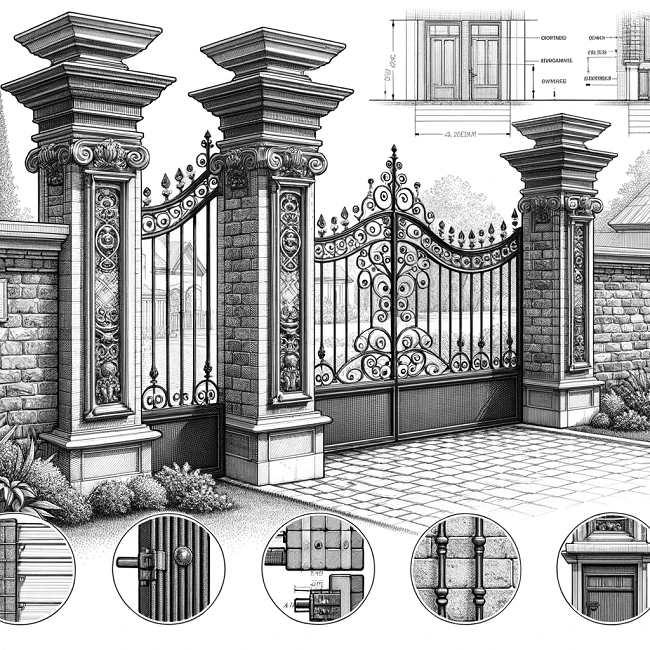Gate pillars serve as essential structural elements in various architectural designs, providing support to gates, fences, and often serving as aesthetic focal points. Proper design and construction of gate pillars are crucial to ensure their stability, functionality, and visual appeal. In this guide, we’ll explore the key aspects of gate pillar design and construction in detail.
1.Planning and Design:
Table of Contents
Before beginning the construction of gate pillars, thorough planning and design are essential. Consider the following factors:
-
- Location and Purpose: Determine the gate’s location, its intended purpose (e.g., security, aesthetics, or both), and how it fits into the overall landscape or architectural design.
- Materials: Choose appropriate materials for your pillars, such as brick, stone, concrete, or metal, based on your design preferences, budget, and durability requirements.
- Style and Aesthetics: Decide on the style and aesthetics of the pillars, considering the architectural style of your property. Traditional, modern, or custom designs can be chosen based on personal preference.
- Dimensions: Determine the height, width, and depth of the pillars. These dimensions should be proportionate to the gate’s size and design.
- Foundation: Assess the soil conditions to determine the appropriate depth and type of foundation needed to support the weight of the pillars.
2.Materials Selection:
The choice of materials greatly influences the appearance and durability of gate pillars. Here are some common options:
-
- Brick: Brick pillars are a classic choice, offering durability and a timeless aesthetic. They can be customized with various brick patterns and colors.
- Stone: Natural stone pillars provide a rustic and elegant look. Stones like granite, limestone, or sandstone are commonly used for their durability and visual appeal.
- Concrete: Precast concrete pillars are versatile, durable, and can mimic the appearance of natural stone or brick. They are also cost-effective.
- Metal: Metal pillars, such as wrought iron or steel, are often chosen for their strength and intricate designs. They can be combined with other materials for a unique look.
3.Foundation and Footing:
Proper foundation and footing are crucial to ensure the stability of gate pillars. The depth and type of foundation depend on the soil conditions and the weight of the pillars. Typically, a concrete footing is poured below the frost line to prevent shifting and settling.
4.Construction Process:
The construction process for gate pillars involves several steps:
-
- Excavation: Dig the foundation hole to the required depth and dimensions, ensuring it is level and properly aligned.
- Concrete Footing: Pour a concrete footing in the foundation hole and allow it to cure. Reinforcement bars may be added for added strength.
- Building the Pillars: Construct the pillars using the chosen materials. Lay bricks or stack stones, ensuring each layer is level and plumb. Mortar or adhesive should be applied between the bricks or stones.
- Capping and Finishing: Add capstones or decorative elements to the top of the pillars for a polished appearance. You can also incorporate design elements like pilasters, columns, or decorative moldings.
- Curing and Sealing: Allow the construction to cure properly, and consider sealing the pillars to protect them from weathering and moisture.
5.Gate Installation:
Once the gate pillars are constructed, it’s time to install the gate itself. Make sure the gate aligns properly with the pillars, and hinges, latches, or automated systems are securely attached.
6.Maintenance:
Regular maintenance is essential to preserve the beauty and structural integrity of gate pillars. Depending on the materials used, maintenance tasks may include cleaning, repointing mortar joints, or resealing.
7.Compliance and Regulations:
Before starting your gate pillar project, be aware of local building codes and regulations. Obtain any necessary permits and ensure compliance with safety standards, especially if the gate is for security purposes.
In conclusion, gate pillars are not only functional but also play a significant role in enhancing the aesthetics of your property. Proper planning, material selection, and construction techniques are essential to ensure the durability and visual appeal of gate pillars. Whether you opt for a traditional brick design or a modern metal structure, well-constructed gate pillars can add both value and beauty to your property for years to come.

